Physical Address
304 North Cardinal St.
Dorchester Center, MA 02124
Cysticercosis is a parasitic infection caused by the larval stage of the tapeworm Taenia solium . The central nervous system (CNS), eyes, and muscles are the most commonly involved sites. Neurocysticercosis (NCC) is considered the most common parasitic infection of the CNS and is a major cause of acquired epilepsy in some areas of the world. It is reported to affect 50 million people, with a prevalence as high as 6% in endemic areas such as Central and South America, Eastern Europe, sub-Saharan Africa, and some parts of Asia. There is a higher prevalence in rural areas, and disease transmission is facilitated by poor living conditions including the lack of sanitation, inappropriate disposal of human feces, inadequate inspection of meat products, and inconsistent personal hygiene. NCC is a major public health concern in most of the developing world and due to globalization, immigration, and international travel over the last century, the infection has become more common in developed countries.
Major advances in neuroimaging techniques have allowed for a more accurate diagnosis and a clearer understanding of the pathogenesis of this parasite in humans.
The life cycle of the Taenia solium parasite is summarized in Fig. 9.1 .
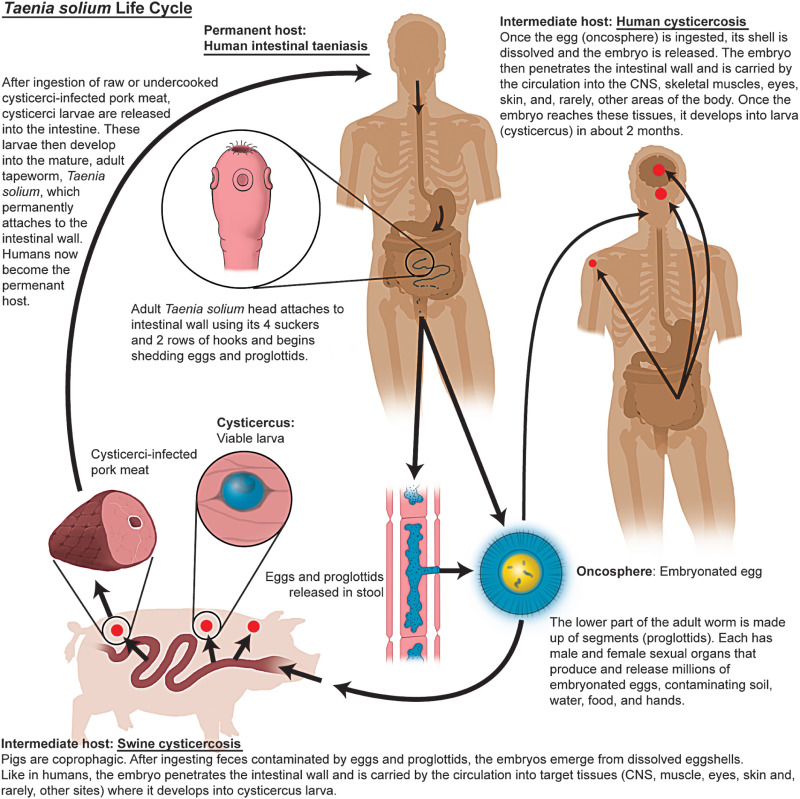
To understand NCC, it is important to first understand the complex life cycle of this tapeworm and the conditions that facilitate transmission of the parasite between definitive and intermediate hosts of the disease. Humans become definitive hosts of the adult tapeworm by ingesting raw or poorly cooked pork meat infected with the Taenia solium larvae. The ingested larva attaches onto the intestinal wall with its suckers and then matures into an adult tapeworm. The lower distal portion of the tapeworm is composed of hundreds of independent segments called proglottids , each of which has both male and female sexual organs. When proglottids become gravid, they harbor fertile eggs known as oncospheres . Gravid proglottids are shed from the adult tapeworm and passed with human feces, releasing thousands of embryonated eggs; these can remain viable for months in water, soil, and vegetation. Pigs become intermediate hosts after ingesting eggs from food contaminated by human feces. Digestive enzymes in the pig's intestines disrupt the eggs, releasing a viable embryo that penetrates the intestinal wall and enters the bloodstream. From the bloodstream, the parasite can lodge in tissues and rapidly evolve into a larva (cysticercus) . The cysticerci are liquid-filled vesicles consisting of two main parts: the vesicular wall and the mature scolex. When humans consume infected, poorly cooked pork meat, the larva develops within the human intestine into a tapeworm and the life cycle is perpetuated.
In contrast to pigs, which act only as intermediate hosts, humans may become definitive (described previously) or intermediate hosts. Specifically, if humans ingest larva-infected pork meat, they become definitive hosts of the tapeworm; that is, while the tapeworm lives within the intestinal lumen, the individual has an infection termed taeniasis . However, if humans ingest eggs via infested food contaminated with human feces or are infected by hand-fecal-oral transmission, the embryo can penetrate the intestinal wall and enter the bloodstream, similar to the mechanism in pigs. After entering the bloodstream, the embryo lodges within tissues and develops into a larva, causing an infection termed cysticercosis . When the CNS is specifically infected, the term NCC is utilized.
In summary, taeniasis and cysticercosis are both caused by a single parasite as a result of two different forms of transmission. Taeniasis develops from the ingestion of viable pork-infected larvae , whereas cysticercosis develops from ingestion of egg -infested fecal material via fecal-oral transmission.
The imaging findings in parenchymal NCC reflect underlying changes in the disease process and host response as the parasite evolves from an embryo into a larval cyst and ultimately into a calcified granulomatous nodule. Five distinct stages based on radiologic findings have been described: (1) noncystic, (2) vesicular, (3) colloidal vesicular, (4) granular nodular, and (5) calcified nodular.
The embryo is often not visible on computed tomography (CT) or magnetic resonance imaging (MRI) in the initial stages when it seeds into the target organ. However, focal areas of parenchymal edema may be seen; these progress to small, homogeneously enhancing lesions within a few months. This occurs during the early stages of evolution when the embryo evolves gradually toward the formation of the larval cysticercus. These findings reflect tissue invasion by the parasite and a secondary host inflammatory response ( Fig. 9.2 ).
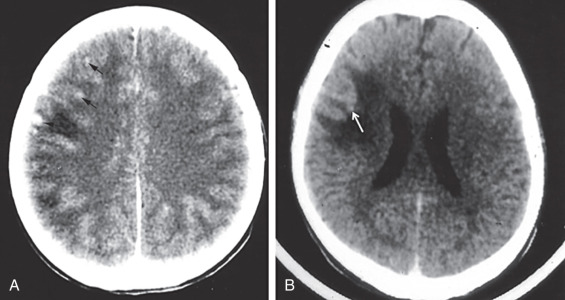
The embryos evolve into cysticerci. These are larval cysts containing clear cystic fluid bathing an invaginated scolex. The cyst wall is rich in glycoproteins and evokes little host reaction as long as it remains intact. They typically range in size from 5 to 20 mm in diameter, exhibiting little to no mass effect. The mature cyst is readily apparent on CT and MRI, presenting as a well-demarcated cyst with a thin nonenhancing wall. The fluid within the cyst is similar to cerebrospinal fluid (CSF) density on CT and to CSF signal intensity on T1, T2, and FLAIR-weighted MRI sequences. The scolex is seen as an eccentric mural nodule within the cyst, typically measuring 2 to 4 mm. On T1 sequences, it appears isointense relative to the brain parenchyma; on T2 sequences, it appears iso- or hyperintense. The scolex may exhibit contrast enhancement. Diffusion-weighted imaging (DWI) reveals a hyperintense, diffusion-restricting scolex surrounded by low-signal fluid with elevated diffusion. This helps to differentiate it from a pyogenic abscess, which will show diffusion restriction of the fluid component on DWI. These cysticerci can remain viable and dormant for years ( Figs. 9.3 and 9.4 ).
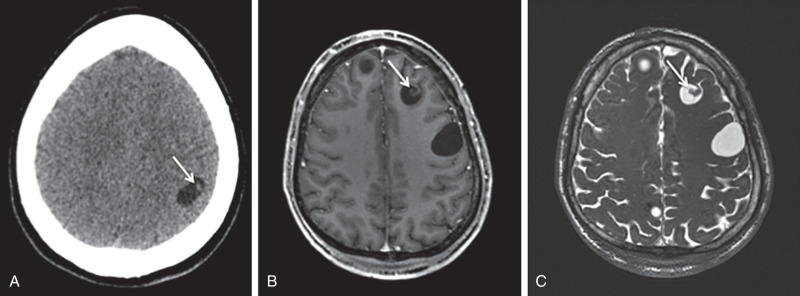
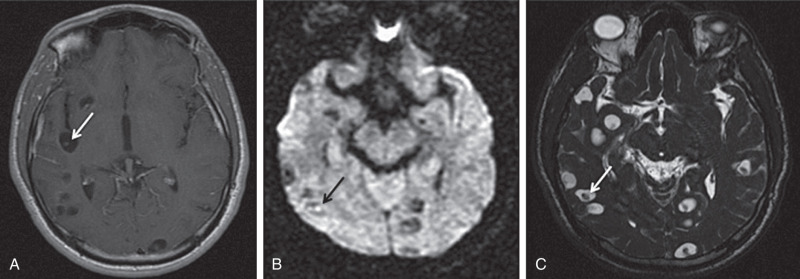
The larvae eventually begin to degenerate, perhaps due to the natural course of infection or because of treatment, invoking an intense host inflammatory response. The cyst fluid becomes turbid due to the accumulation of proteinaceous material and debris. A fibrous capsule develops around the dying larva. As a result, the cyst wall appears thicker and enhances on postcontrast imaging.
CT depicts a ring-enhancing lesion with hyperdense fluid and surrounding edema. On MRI, the internal fluid appears slightly hyperintense to CSF on T1 and hyperintense on T2 and FLAIR sequences. Fluid-fluid levels can be observed within the cyst. Surrounding vasogenic edema appears hypointense on T1, and hyperintense on T2 and FLAIR images. The initially present scolex eventually disappears, rendering scolex-free cystic lesions during the late phase of this stage ( Figs. 9.5–9.7 ).

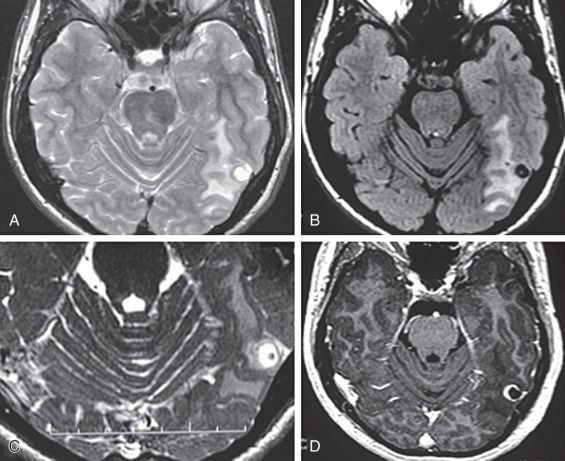
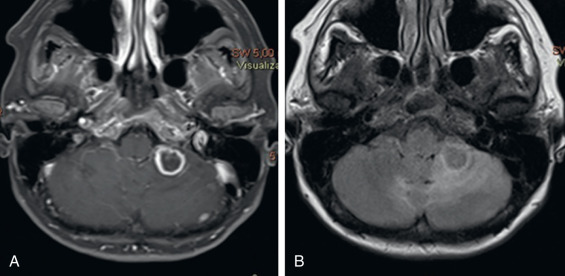
The diagnosis can be challenging in patients with only a single cyst at the colloidal vesicular stage and with findings of ring-like enhancement and surrounding vasogenic edema. Thus a contributory clinical history is of paramount importance. In patients with numerous lesions in this stage, encephalitis can occur, and the ensuing host inflammatory response can cause diffuse brain edema and collapse of the ventricular system. This is particularly seen in children and after the use of oral antihelminthic agents.
Become a Clinical Tree membership for Full access and enjoy Unlimited articles
If you are a member. Log in here